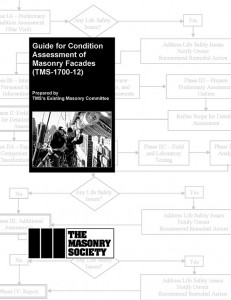Question
For the critical examination or condition assessment of masonry façades, what is a good reference for practicing engineers to use?

“Guide for Condition Assessment of Masonry Façades”, TMS-1700-12, from The Masonry Society.
Answer
A good, comprehensive reference document that specifically addresses masonry façades is the recently published Guide for Condition Assessment of Masonry Façades (Guide) from The Masonry Society. It is different from the current stock of available documents that address a variety of systems that may be used in a building envelope. This Guide provides the methodology for assessing the condition of most any masonry façade, including terra cotta, and of any masonry detailing, including cornices, parapets, appurtenances, chimneys, and penthouse walls. It is intended to be a “living document” that will be amended periodically as the process is updated, techniques are changed, and the Appendix is expanded.
For the practicing structural engineer, the Guide can be used for various purposes such as satisfying a local façade ordinance, preparing a due diligence report, formulating a maintenance program, or investigating masonry defects. Other audiences of the Guide may be building owners, agents representing the building owner, and building officials needing direction for, or an understanding of, masonry façade condition assessments.
Early in the document, the Guide discusses factors that affect masonry performance, such as: gravity support, wind anchorage, seismic detailing, durability, and aesthetics. Each factor lists possible failure characteristics and the related defects that may be seen in a masonry façade. These portions of the Guide were written by practicing engineers experienced in the design and investigation of masonry.
The main body of the Guide delineates the process for examining masonry façades. Starting with preparation before the site visit, the outline follows through the entire field investigation, testing, analysis, possible additional assessments beyond masonry façades, and the final reporting. The field investigation section is itemized to identify various masonry façade materials, components, systems, fenestrations, and hazardous materials possibly encountered. Visual observations are further discussed regarding documentation and defect types. The testing portion contains a comprehensive list of the current laboratory and field methods available, and it refers to the Appendix for more specific details on in-place test methods. Analysis of the assessment is discussed, including determining the causes of various masonry defects based upon the results of the field and laboratory work. Additional assessments that can occur are listed including those of other building envelope systems that are directly adjacent to, or impact on, the masonry façade. Lastly, where the final reporting is not dictated by local façade ordinances, a suggested written format is provided.
The façade examination process is also graphically shown in a flowchart that contains checkpoints for “life safety issues” that may be revealed during the assessment. At any checkpoint, there are the “Yes” or “No” answers with arrows moving toward the next step. If there are any “life safety issues”, then the next step is to notify the building owner and recommend remedial action. After addressing the “life safety issues”, then the condition assessment process continues.
Unique to the Guide is the Appendix that currently contains the special topics of: Distress Common to Terra Cotta Façades and Assessment Techniques of In-Place Masonry. Items covered in Distress Common to Terra Cotta Façades are a variety of defects that are typically seen only by close or intrusive examination. In Assessment Techniques of In-Place Masonry, both non-destructive and partially invasive methods are addressed.
Currently, the Guide is available in printed form through The Masonry Society. In the future, it may also be available for on-line downloading. Watch for revisions to the Guide for Condition Assessment of Masonry Façades in future years.▪
